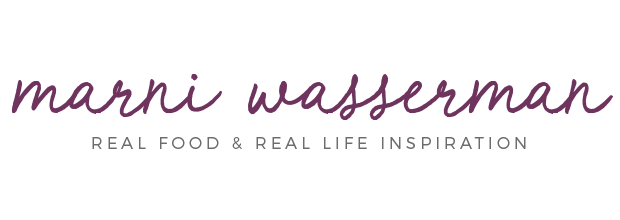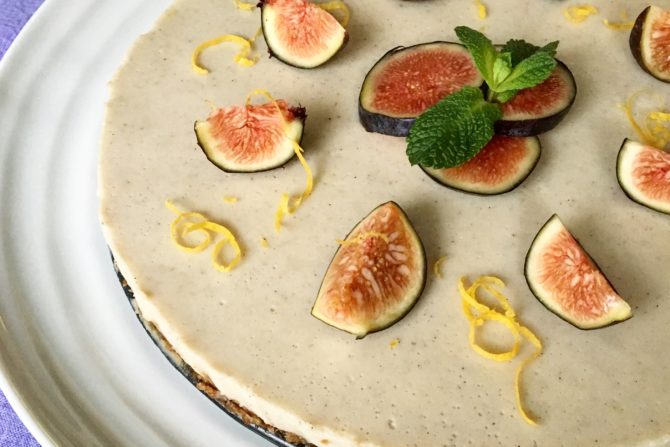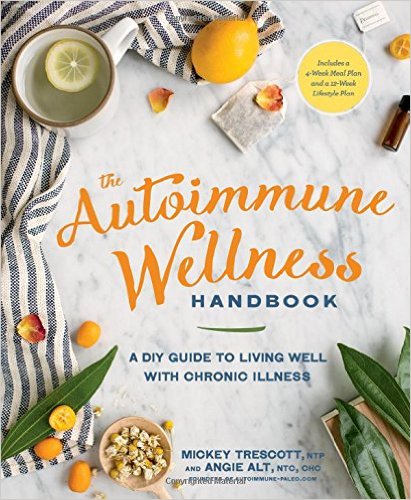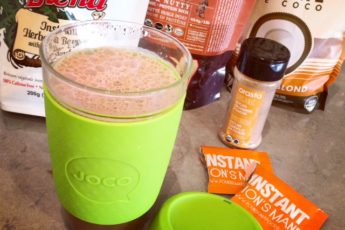I am so grateful that Mickey Trescott and Angie Alt came into my life at just the right time. They have their own personal stories and have together created Autoimmune Wellness, a community dedicated to healing and eating well. They also have an incredible book, The Autoimmune Wellness Handbook (which was truly my guide) and Mickey has put together the Autoimmune Paleo Cookbook. These two resources, along with Sarah Ballantyne’s book The Healing Kitchen provided everything I needed to make my transition to eating delicious food without deprivation. Everything that I made turned out amazing and was super colourful and vibrant. I must highlight that my favourite recipe from the Autoimmune Wellness Handbook was the no -bake lemon vanilla cheesecake. Although it’s not the simplest recipe to tackle, eating it made me feel like I wasn’t on any protocol at all! See the recipe below
I am very excited to share this interview that I did with Mickey and Angie, as they outline some of the common questions that someone may have wanting to try this approach to eating. These were questions that I had, so I figured why not go to the source. So below I will have them impart their knowledge to anyone reading this that may find some resolution in trying on AIP as a temporary fix or better yet, a way of life!
What is AIP and why would someone consider trying this approach to eating?
Mickey: The Autoimmune Protocol is an elimination and reintroduction protocol that helps people get to the root of their food-driven symptoms. It removes the most common gut irritants and triggers in the diet, and then by reintroducing them one by one, a person is able to come up with a personalized healing diet. In addition, it includes foods that contain extra nutrient density that help boost the healing process. Anyone with chronic illness or autoimmune disease can use this template to find out which foods are causing them harm, and which foods are boosting their health.
What are the most common inflammatory foods and why?
Angie: Specifically, for those with autoimmune disease, but really for even the healthy population, the top two most common inflammatory foods are probably gluten and sugar. I think that most people can benefit from removing or dramatically reducing gluten and sugar in their diets.
A component of gluten found in grains (wheat, barley, and rye specifically) known as gliadin is the best-known example of a prolamin (which is a type of lectin). Specifically, gliadin fragments cross the gut barrier, and once inside the body, these protein fragments interact with the gut associated lymphoid tissue, stimulating the release of inflammatory cytokines and activating cells of both the innate and adaptive immune system. Through this process, gliadin causes damage of gut enterocytes, which results in the creation of holes in the gut barrier through which various contents of the digestive system can leak into the body. Inflammation is triggered by gliadin fragments that cross the gut barrier, as well as by other partly digested food proteins, gut bacteria, bacterial fragments, and waste products, like toxins, crossing over. This further activates the immune system, causing a vicious cycle of inflammation and gut-barrier damage, and is why the gluten-containing grains (wheat, barley, and rye) are typically the most problematic for those with gut issues or autoimmune disease.
The problem with sugar is that over-consumption leads to issues with blood sugar regulation, which can look like insulin resistance, high blood sugar levels, hypoglycemia, and diabetes. Regulating blood sugar levels and maintaining insulin sensitivity are critical to regulating the immune system and reducing inflammation.
How does it differ from a typical paleo diet?
Mickey: The Autoimmune Protocol omits some of the same foods as a Paleo diet, like grains, legumes, and dairy. It goes a bit further though, with the elimination of eggs, nuts, seeds, and nightshade vegetables because components of these foods have been shown to cause issues for some folks.
What are the most common conditions for transition to an AIP diet?
Angie: If you mean what autoimmune diseases do we most commonly see trying the AIP diet in our community, there’s a wide variety of diagnoses. We see Hashimoto’s as far and away the most common, but there are also many with digestive diseases like celiac, Crohn’s, and ulcerative colitis, as well as arthritis and skin diseases, like psoriasis. We also see folks with lupus, Sjorgen’s, and other diseases giving AIP a shot. It’s awesome to see so many people with different autoimmune challenges attempt such an empowered way to heal.
Hypothyroid/Hashimoto’s seems to be a common problem among many who choose to eat AIP – can this be reversed by following AIP?
Mickey: Hashimoto’s disease is the most common autoimmune disease, and the most common cause of hypothyroidism, so it is very common in our community. The elimination diet is a great way for thyroid patients to lower inflammation and get at the root of their food-driven symptoms, and can be a great addition to complementary care by a medical practitioner for prescribing thyroid replacement hormone. Hashimoto’s can’t be reversed, but with diet and lifestyle in check, and sometimes the right thyroid replacement hormone, people can live energetic, full lives.
How is eating AIP beneficial to the gut lining?
Angie: In the simplest terms, AIP removes foods that damage and inflame the gut lining, while emphasizing very nutrient dense foods that are healing and calming to the digestive tract. For instance, studies show that the 17 different amino acids in bone broth, which is emphasized on AIP, reduce inflammation. Glutamine specifically is anti-inflammatory for the gut.
When making changes to your diet it can often be confronting and isolating, what do you suggest to people to get the support they need?
Mickey: I suggest that people plug into the online community – find some blogs authored by those who have similar conditions, find some podcasts you love, and participate on Instagram. We have a listing of worldwide local in-person meetup groups published monthly on our site, for those who want to host and/or attend potlucks and other gatherings with their local AIP community. Support is so important to making these changes stick!
The AIP diet can be quite limiting, how do you suggest making it fun and innovative?
Angie: The elimination phase of AIP is limiting if you are very focused on eating out or resistant to trying a bit of a counter-culture move for your health, but the reality is that for those open to it, it can really spark culinary creativity. If you decide to embrace your kitchen and try new things it can be very fun. I suggest folks first start with very simple meals, made in batches to avoid overwhelm. As they get comfortable and familiar with using their kitchen often, they can start challenging themselves to trying one new ingredient or one new recipe every week. There are literally thousands of recipes online, 200 on our website alone, so the possibilities to experiment are endless. A person trying even just one new recipe a week is not going to be bored.
People also fear they are not going to have enough variety eating this way, is this true?
Mickey: This is a big misconception as the foods to include list is actually much bigger than the foods to avoid list, and there are thousands of AIP recipes available in various cookbooks and online (we have over 200 available on our site alone!). For those who are concerned about variety, try “geeking out” on a new vegetable or meat type every week. Never tried kohlrabi, daikon radish, or sardines? Make it your mission that week to find a way to cook and enjoy these new ingredients!
As someone makes introductions of the common culprits, can they still benefit from the AIP approach?
Angie: Absolutely! It’s a misconception that the elimination phase goes on forever. AIP has an equally important reintroduction phase. This the chance for people to begin learning which foods agree with them and work well for their bodies and which foods are a mismatch. It’s the process of individualizing the AIP template, making the diet personal. If you do a careful job of reintro, paying attention to your body’s signals about what does and does not work, you are still benefiting from nourishing foods that are right for you.
You have so many recipes in your cookbook some recipes more complicated than others, how can eating AIP be approachable to the novice cook?
Mickey: We are all about making this lifestyle accessible to people, and the truth is those of us who have been eating this way for years know that in order for it to be sustainable, it can’t be too complex. Sure, making an AIP cake is nice for a special occasion, but most of our meals day in and day out are simple renditions of meat, veggies, and interesting spice blends.
It appears that animal protein is big part of AIP – why is this?
Angie: It’s a myth that animal protein is a big part of AIP. We emphasize a balanced approach to the macronutrients. Protein, fats, and carbohydrates all play an important role in a healthy body. We do focus on high-quality animal protein. This is because grass-fed, pastured, and wild-caught animal protein sources are higher in the nutrients necessary to encourage healing and restore those with autoimmune disease to better health.
Can someone who is vegan or vegetarian thrive on this approach to eating?
Mickey: It isn’t recommended to do the elimination diet as a vegan or vegetarian because there is not enough protein or sources of nutrients without meat. I was personally vegan for 10 years before coming to this protocol to save my health when I was having a hard time healing from multiple nutrient deficiencies. If a person is willing to eat fish and shellfish, they can do the elimination diet, and even better if they can eat some fowl (like chicken). When I made my transition, I thought of meat medicinally, only eating the highest quality, ethically sourced, and smallest amount to get the nutrition I needed. The Autoimmune Protocol is not a meat-heavy diet, and most can get by with smaller portions of meat as long as they are high-quality.
Do you find that a lot of people who are previously vegan are ones that turn to this way of eating because of a compromised gut?
Mickey: I don’t believe it is because of a compromised gut, I believe it is because of the extreme nutrient deficiencies present in even a very high-quality vegan diet. Nutrients like iron, B12, zinc, vitamin A, and omega-3 fatty acids are either impossible or very hard to get on a vegan diet, and I believe these depletions, especially when combined with autoimmune disease, leads people to finding a more nourishing and healing way to eat.
I really want to thank these ladies for providing so much insight and detail on some common questions for following an AIP Diet. Now on to dessert…
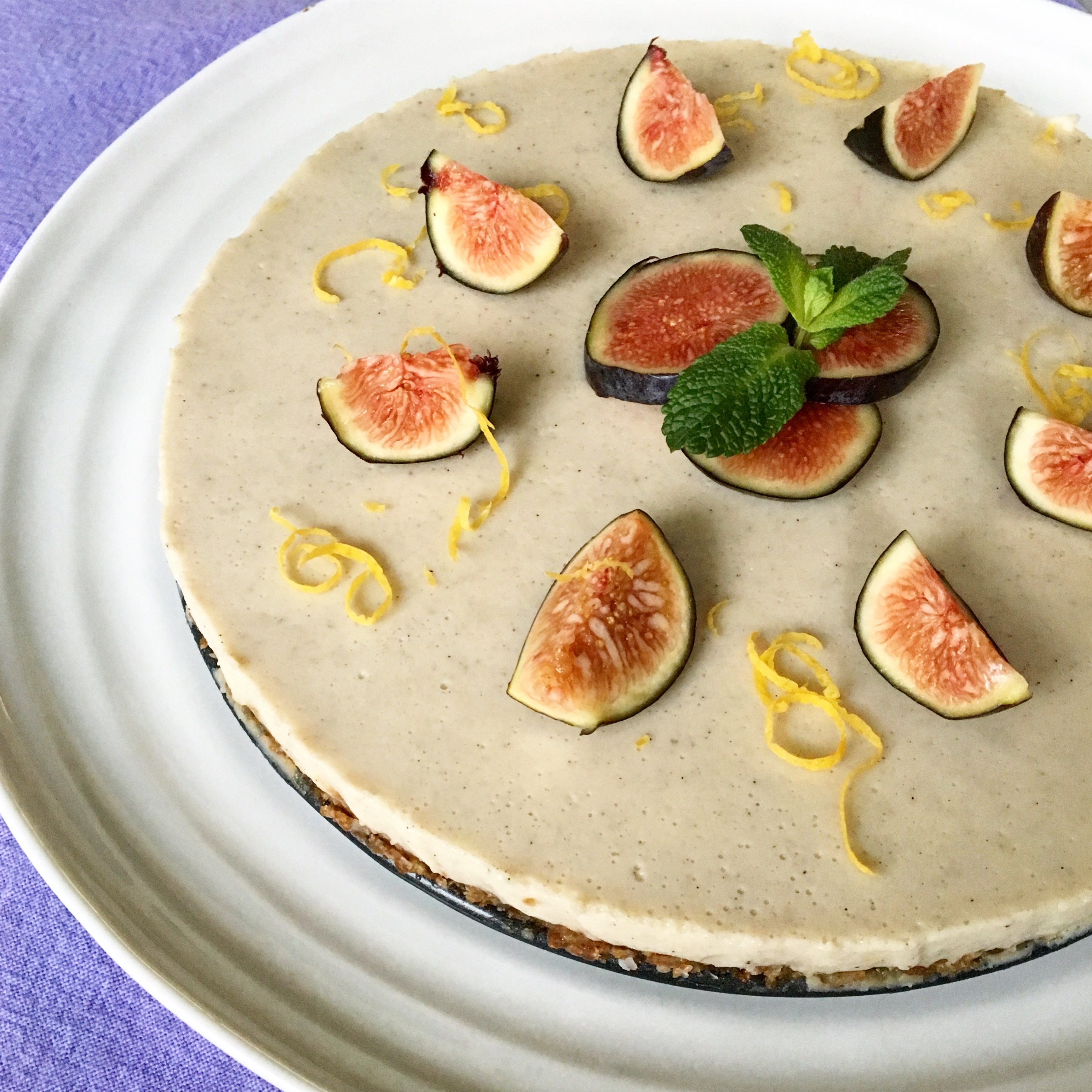
No Bake Lemon Vanilla “Cheesecake”
Crust:
11/2 cups dried figs
1/2 cup dried dates
1/2 cup unsweetened coconut flakes
1 tablespoon arrowroot starch
1 tablespoon melted coconut oil
Pinch of sea salt
Coconut oil for greasing the pan
Filling:
1 cup filtered water
2 teaspoons grass-fed gelatin
1 cup coconut concentrate melted (also known as coconut manna/butter)
1/2 cup raw honey, mleted
1/2 cup lemon juice (about 4 lemons)
2 tablespoons lemon zest
1 whole vanilla bean, minced
1/4 teaspoon sea salt
- Place the dried figs, dates, coconut flakes, arrowroot, coconut oil and sea salt in a food processor and process on high until a thick, sticky, homogenous paste forms. Grease an 8″ springform cake pan with the coconut oil, add the crust mixture and spread evenly into the bottom of the pan with your fingers. Put it in the refrigerator to cool while you make the filling.
- Place the water in a small saucepan and sprinkle the gelatine on top, giving it a few minutes to absorb some of the liquid and “bloom”.
- Meanwhile, combine the coconut concentrate, honey, lemon juice, lemon zest, vanilla bean and sea salt in a blender or food processor and blend on high for 30 seconds to combine. Set aside.
- Place the saucepan with the gelatine on the stove and turn the heat on low. Heat the mixture very gently, stirring, only about 30 seconds or until the gelatine has dissolved completely. Do not let it get more than lukewarm.
- Add the gelatine mixture to the blender or food processor with the rest of the filling ingredients and blend again, on high until everything is well incorporated.
- Pour onto the crust and cool in the refrigerator until firm, about 24 hours.
- Garnish with fresh figs and mint if desired.
For More insight on AIP and Paleo eating
Listen to ROBB WOLFE on The Ultimate Health Podcast!
Listen to Sarah Ballantyne on The Ultimate Health Podcast
Listen to Sarah Ballantyne again on The Ultimate Health Podcast
Listen to Sam Gladish on The Ultimate Health Podcast
Listen to Datis Kharrazian on The Ultimate Health Podcast
